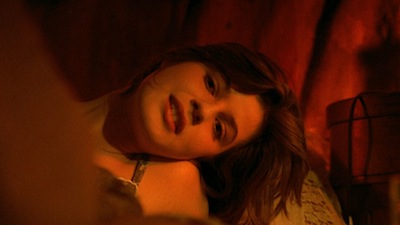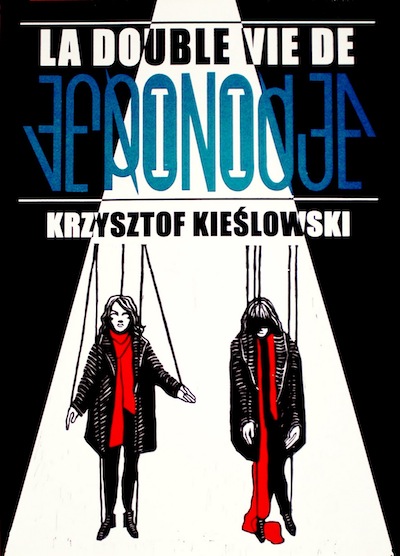
For this viewing of The Double Life of Véronique I did something I generally don't do: I read my old review. It's been over four years since the DVD of The Double Life of Véronique was first released, and so that long since I last saw it. I was curious what the me of 2006 had to say about the picture. Was I insightful? Was I way off base? Would how I thought then be a way of thinking I'd even recognize now?
These questions of intellectual identity aren't just the curiosity of a writer who sees how he writes about cinema as an ongoing process, but they are also thematically in tandem with the philosophical and metaphysical questions Krzysztof Kieślowski poses in his 1991 masterpiece. Is it possible that we are more than one person? Forget the idea of a physical double for a second. Maybe the way our thought processes evolve creates separate, parallel versions of ourselves. When we change our minds, some version of who we are splinters off and becomes its own entity.
There is certainly that kind of magical thinking within Kieślowski's screenplay. One could interpret a variety of different reasons for why there is a Polish Weronika and a French Véronique (both played with a fragile intensity by Irène Jacob). Both versions wake up startled from dreams at different times, so maybe one is dreaming the other. Both fixate on an image of one version of themselves during sex, possibly creating a dissociative fantasy. Maybe they are a manifestation of the puppeteer (Philippe Volter) and the fictions he creates. His seduction of Véronique follows the outline of one of his books, and he does create two marionettes in the women's image. Or maybe the external force is the filmmaker, as it is his fiction after all, and there is no more explanation needed here than there is for the sudden change of actresses in Luis Buñuel's That Obscure Object of Desire. It is what it is, the question answers itself. For some reason, I was also reminded of Abbas Kiarostami's Certified Copy [review], particularly in the way Alexandre, the puppeteer, chased Véronique through the street; maybe we could interpret, as one could with Kiarostami's couple, that the game they are playing stops being play and becomes real.

Because up until that point, Alexandre is playing a game with Véronique. He remodels courtship as a kind of scavenger hunt, but one where the disparate pieces of the puzzle are sent to her instead of Véronique having to seek them. It's a love letter delivered as code, and like the riddle of the Sphinx, if you crack it, something remarkable awaits. When she surrenders, all kinds of things begin to happen. Exactly what...ah, well, that's still part of the mystery.
It's amazing how much one can forget about a movie in the years between viewings, and it's also amazing how much more you can notice once you have a basic idea of what you are in for. On one hand, there was so much in The Double Life of Véronique that felt new to me, I almost questioned whether I had seen it at all. Specific scenes and turns of the plot had been lost to my fading brain power. For instance, had I ever seen the Polish woman who had come to Paris, who spies Véronique and recognizes Weronika in her, thus connecting the doppelgangers? I'm not sure.
At the same time, it's interesting to note how much takes on deeper significance precisely because of what you do remember. It's like watching a murder mystery when you know who the killer is. All of that person's actions take on added meaning. Right from the start of The Double Life of Véronique, I was acutely aware of different visual cues, of small gestures or indicators, and of the surreal aura Kieślowski cloaks everything in. The storytelling here is almost episodic, even disjointed, yet one must assume everything is placed where it is for a specific purpose. For instance, the statue of a communist leader that Weronika sees being hauled away at the start of the movie could have a variety of meanings. On one hand, there is the political interpretation. In the early 1990s, European communism was failing. Symbolically, the man immortalized in stone is now the one being tied down and hauled off. He is taken away, and in his place is freedom.
Yet, if we know that later there will also be life in miniature, that the puppets will also be carved imitators of life that require their own string, then the statue is foreshadowing. Going from one to the other is going from large to small, from a universal symbol to an individual one. Our heroine complains of a feeling of not being alone in the world, and that feeling could just as easy be her connection to her fellow man. None of us are alone, we're all in this together.
It's an unknowable feeling, immutable. Like the light that lingers in Véronique's apartment even though the reflective surface is withdrawn, or the reoccurring chord that binds the women together though its origins are unknown. Or maybe it's not so unknowable, maybe it's simple. Like the removal of the dictator gives the Polish people freedom, so too does Weronika's fate make way for Véronique's blossoming. Alexandre's puppet show portrays a ballerina who breaks her leg, and yet despite the crippling injury, she wants to keep dancing. Her will is so strong, she transforms into a butterfly and flies away. Weronika is the ballerina, and Véronique the colorful insect who takes flight.
Before I wrap up, special mention should be made of the fact that this viewing was also my first time watching The Double Life of Véronique on Blu-Ray. Kieślowski's movie looks astounding in high-definition. The Double Life of Véronique is a film that is intricately designed, with specially tuned color palettes and a meticulous attention to every corner of the image frame. The light in this new digital version is warm and full of undulations, and the tiniest detail is given equal due. Take a look at the scene where Irène Jacob is bouncing the rubber ball and she dislodges dust from the ceiling. Minute particles rain down on her, and on Blu-Ray, each one is its own individual sparkle, a glittery cloud of fairy dust.
In terms of supplements, the new edition is an exact copy of the DVD release. The only thing that has changed is the packaging...which kind of sucks by comparison. I can appreciate the compact nature of the small Blu-Ray case, but I prefer the handsome box and book version, which was more like its own art object, a physical treasure chest to unfold, than it was merely functional. For that alone, I'll likely be hanging on to both versions of The Double Life of Véronique even though I'm only likely to actually watch the Blu.

This cool poster by artist Joanna Lisowiec is something I stumbled across doing a search for, well, Double Life of Veronique posters. She made it for a contest. I hope it wins!
This disc was provided by the Criterion Collection for purposes of review.

1 comment:
And if the statue had the word freedom at its base then it was freedom that was being towed away. Knowing Kieslowski he would have scratched the word in chalk and then rubbed it off. The grave of Mme Blode (Veronique's deceased mother) at Chambon-sur-Lac... I went to have a look last year to find out but you probably heard the story already. Un de ces jours.
Alexandre FABBRI
KIESLOWSKI'S WORLD
Post a Comment